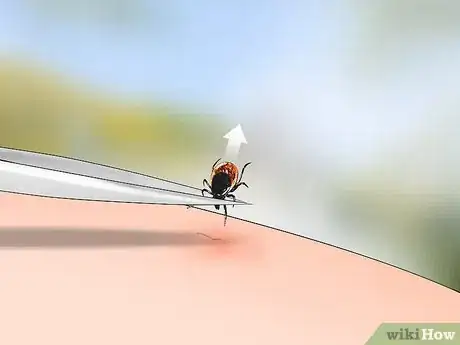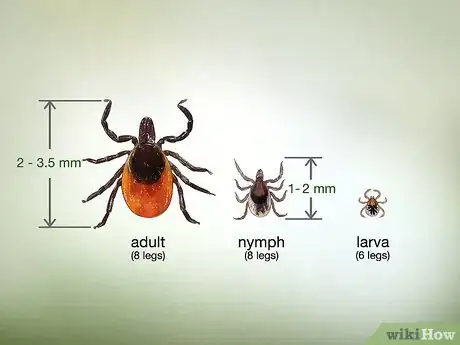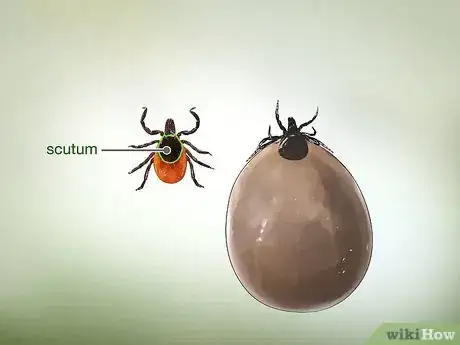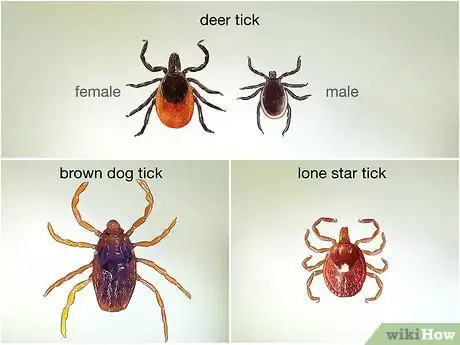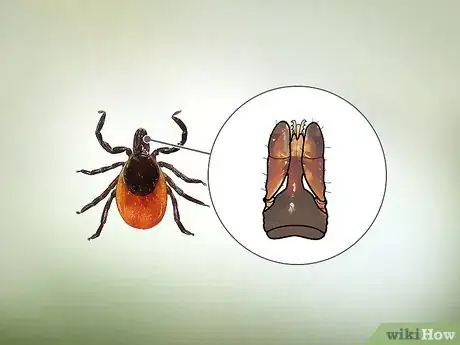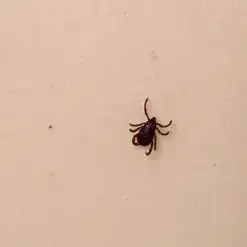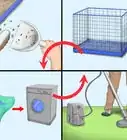This article was co-authored by Pippa Elliott, MRCVS. Dr. Elliott, BVMS, MRCVS is a veterinarian with over 30 years of experience in veterinary surgery and companion animal practice. She graduated from the University of Glasgow in 1987 with a degree in veterinary medicine and surgery. She has worked at the same animal clinic in her hometown for over 20 years.
There are 11 references cited in this article, which can be found at the bottom of the page.
wikiHow marks an article as reader-approved once it receives enough positive feedback. This article received 22 testimonials and 83% of readers who voted found it helpful, earning it our reader-approved status.
This article has been viewed 797,857 times.
Of the over 80 types of ticks active in North America, there are only seven species that can transmit disease to humans through its bite. The deer tick, or blacklegged tick (Ixodes scapularis) can transmit Lyme disease and other illnesses to its hosts. Ticks are most easily identified in their adult stage, but disease can be transmitted in the nymph stage as well.[1] If a tick bites you or attaches itself to your clothing, it's important to be able to identify whether or not it is a deer tick so you can get prompt medical attention if needed.
Steps
Examining the Tick
-
1Remove the tick from its host, if necessary. The best way to remove the tick is to use pointy-edged tweezers, angling the points to ensure that the head of the tick is removed along with the body.[2] Old-fashioned methods, such as soaking it with petroleum jelly or painted the affected site with nail polish, should be avoided as they traumatize the tick, which may then regurgitate its stomach contents (including bacteria) into the dog's bloodstream.
- Did you remove the whole tick? If you've jerked or twisted the tick while removing it, the mouth-parts may break off and remain in the skin. You may be able to remove the mouth-parts separately using clean tweezers.[3] You should still be able to identify the tick without the mouth-parts.
- Put the tick in a vial or lidded jar, or place it on a piece of white paper and use a piece of clear tape to cover it.
-
2Confirm that it's a tick. How many legs does it have? Ticks, like other arachnids, will have eight legs in the nymph and adult stage, but will have only six legs in the larval stage.[4]
- If you've put the tick in a jar or vial, watch it move. If it is a tick, it will crawl, but will not be able to fly or jump.
- Ticks have flattened, tear-shaped bodies at all stages of growth. When engorged, the tick's body will be rounded and its color will be lighter.
- Deer ticks are smaller than their counterparts, the dog and lone star ticks. Deer tick nymphs are typically the size of a poppy seed, 1 to 2 mm (.039 to .078 inches) in diameter, while adults range from 2 to 3.5 mm (.078 to .137 inches) and are roughly the size of a sesame seed. An engorged tick may be about 10 mm long.[5]
- Hard ticks, such as the deer tick, have a scutum or shield covering the body.[6] Soft ticks do not have this feature.
Advertisement -
3Examine the tick's "scutum," or shield. A magnifying glass can be helpful, as ticks in pre-adult stages are quite small.
- The scutum is the hard section behind the tick's head. A deer tick will have a solid-color scutum, while the shield of other ticks is patterned.[7]
- The scutum can also provide information about the gender of the tick.The scutum of the adult male will cover most of the body, while that of the female will be much smaller.
- If the tick is engorged (after feeding) it can be hard to identify by other characteristics. An engorged deer tick will be rust- or brown-red in color, while the color of other engorged ticks may be pale gray or greenish-gray.[8] However, the scutum will remain unchanged.
Telling Deer Ticks from Other Ticks
-
1Identify the tick by its markings. Unfed adult female deer ticks have a unique bright orange-red body surrounding the black scutum. Adult males are dark brown to black in color. [9]
- The name "wood tick" is used for a number of different ticks, including the deer tick, lone star tick, and American dog tick. All three ticks tend to live in wooded or recently cleared areas, and crawl up from the ground. You'll need to look to their markings to tell them apart.
- Brown dog ticks will have mottled brown and white markings on their scutums, which deer ticks do not have. The lone star tick has a distinctive white star-like marking on its scutum.
- The deer tick is about half the size of the brown dog tick, both in its pre-fed state and when engorged.
- Brown dog ticks rarely attach to humans.[10] However, they are one of the few ticks that can infest a home. As the name implies, they're frequently carried by dogs, and can be found in kennels, around veterinary offices, and outdoor areas frequented by infected animals.
-
2Look at the length of the tick's mouthparts, or "capitulum." It may look like a head, but this is the part of the tick that attaches to the host in order to feed. It consists of two leg-like sensory structures that detect the presence of a host, a pair of knife-like structures that allow the tick to cut through the skin, and a single barbed structure (the "hypostome") that enters this opening.[11]
- The capitulum on the deer tick is much longer than in other common ticks, such as the dog tick. The capitulum is positioned to the front, and visible from above.[12]
- The female deer tick has a larger capitulum than a male deer tick. Adult male deer ticks do not feed.
-
3Consider where you found the tick. Deer ticks are particularly well-established along the Eastern and Upper Midwestern United States, but can be found as far south as Texas and into Missouri, Kansas, and parts of Oklahoma.[13]
- Deer ticks are most active in the spring, summer and fall. However, they may be active whenever the temperature is above freezing. Other forms of ticks, such as the dog tick, are generally most active in spring and summer months only.[14]
- The adult form of the deer tick lives in woody, brushy habitats. They prefer low-lying shrubs, not trees.[15]
- The Western Blacklegged Tick is another form of the deer tick, found along the Pacific Coastal regions. It is especially active in Northern California. This form of tick rarely attaches to humans.[16]
Expert Q&A
Did you know you can get expert answers for this article?
Unlock expert answers by supporting wikiHow
-
QuestionWhat does a tick look like?
 Melissa Nelson, DVM, PhDDr. Nelson is a Veterinarian who specializes in Companion and Large Animal Medicine in Minnesota, where she has over 18 years of experience as a veterinarian in a rural clinic. She received her Doctor of Veterinary Medicine from the University of Minnesota in 1998.
Melissa Nelson, DVM, PhDDr. Nelson is a Veterinarian who specializes in Companion and Large Animal Medicine in Minnesota, where she has over 18 years of experience as a veterinarian in a rural clinic. She received her Doctor of Veterinary Medicine from the University of Minnesota in 1998.
Veterinarian
-
QuestionHow soon after being bitten by a tick do symptoms appear?
 Melissa Nelson, DVM, PhDDr. Nelson is a Veterinarian who specializes in Companion and Large Animal Medicine in Minnesota, where she has over 18 years of experience as a veterinarian in a rural clinic. She received her Doctor of Veterinary Medicine from the University of Minnesota in 1998.
Melissa Nelson, DVM, PhDDr. Nelson is a Veterinarian who specializes in Companion and Large Animal Medicine in Minnesota, where she has over 18 years of experience as a veterinarian in a rural clinic. She received her Doctor of Veterinary Medicine from the University of Minnesota in 1998.
Veterinarian
-
QuestionCan you see deer ticks?
 Melissa Nelson, DVM, PhDDr. Nelson is a Veterinarian who specializes in Companion and Large Animal Medicine in Minnesota, where she has over 18 years of experience as a veterinarian in a rural clinic. She received her Doctor of Veterinary Medicine from the University of Minnesota in 1998.
Melissa Nelson, DVM, PhDDr. Nelson is a Veterinarian who specializes in Companion and Large Animal Medicine in Minnesota, where she has over 18 years of experience as a veterinarian in a rural clinic. She received her Doctor of Veterinary Medicine from the University of Minnesota in 1998.
Veterinarian
Warnings
- If you suspect you may have a deer tick bite, see a doctor immediately for treatment. Treatment for Lyme disease when caught within two weeks is usually successful.⧼thumbs_response⧽
- Disease is most commonly acquired from deer ticks in the nymph stage. Because nymphs are much smaller than adult ticks, they're less likely to be caught and removed quickly.⧼thumbs_response⧽
References
- ↑ http://www.cdc.gov/ticks/geographic_distribution.html
- ↑ http://www.tickencounter.org/faq/tick_removal
- ↑ http://www.cdc.gov/lyme/removal/
- ↑ https://www.orkin.com/pests/ticks/deer-ticks
- ↑ https://www.orkin.com/pests/ticks/deer-ticks
- ↑ http://dictionary.reference.com/browse/scutum
- ↑ http://www.tickencounter.org/tick_identification/guide
- ↑ https://www.orkin.com/pests/ticks/deer-ticks
- ↑ http://www.tickencounter.org/tick_identification/deer_tick
- ↑ http://www.tickinfo.com/deertick.htm
- ↑ https://www.ent.iastate.edu/imagegal/ticks/dvar/hypostomes.html
- ↑ http://extension.entm.purdue.edu/publichealth/insects/tick.html
- ↑ http://www.cdc.gov/ticks/geographic_distribution.html
- ↑ http://www.cdc.gov/ticks/geographic_distribution.html
- ↑ http://www.health.state.mn.us/divs/idepc/dtopics/tickborne/ticks.html
- ↑ http://www.cdc.gov/ticks/geographic_distribution.html
About This Article
Deer ticks are about the size of a sesame seed and are the smallest species of tick in North America. Deer ticks have a black head, 8 black legs, and a red, tear-shaped body, although they turn brown and become slighty rounded when they're engorged after feeding. They're usually found in the southern and eastern United States, although you may spot one in the Great Lakes region of the Midwest as well. They are most active in the spring, summer and fall. If you think you’ve been bitten by a deer tick, first wash your hands with soap and water. Then, wash then bite with warm, soapy water or rubbing alcohol. Seek emergency medical care if you develop a headache or have difficulty moving or breathing. Otherwise, see your doctor within a week to have the bite inspected since you may need antibiotics. To learn how to remove a tick, keep reading!
